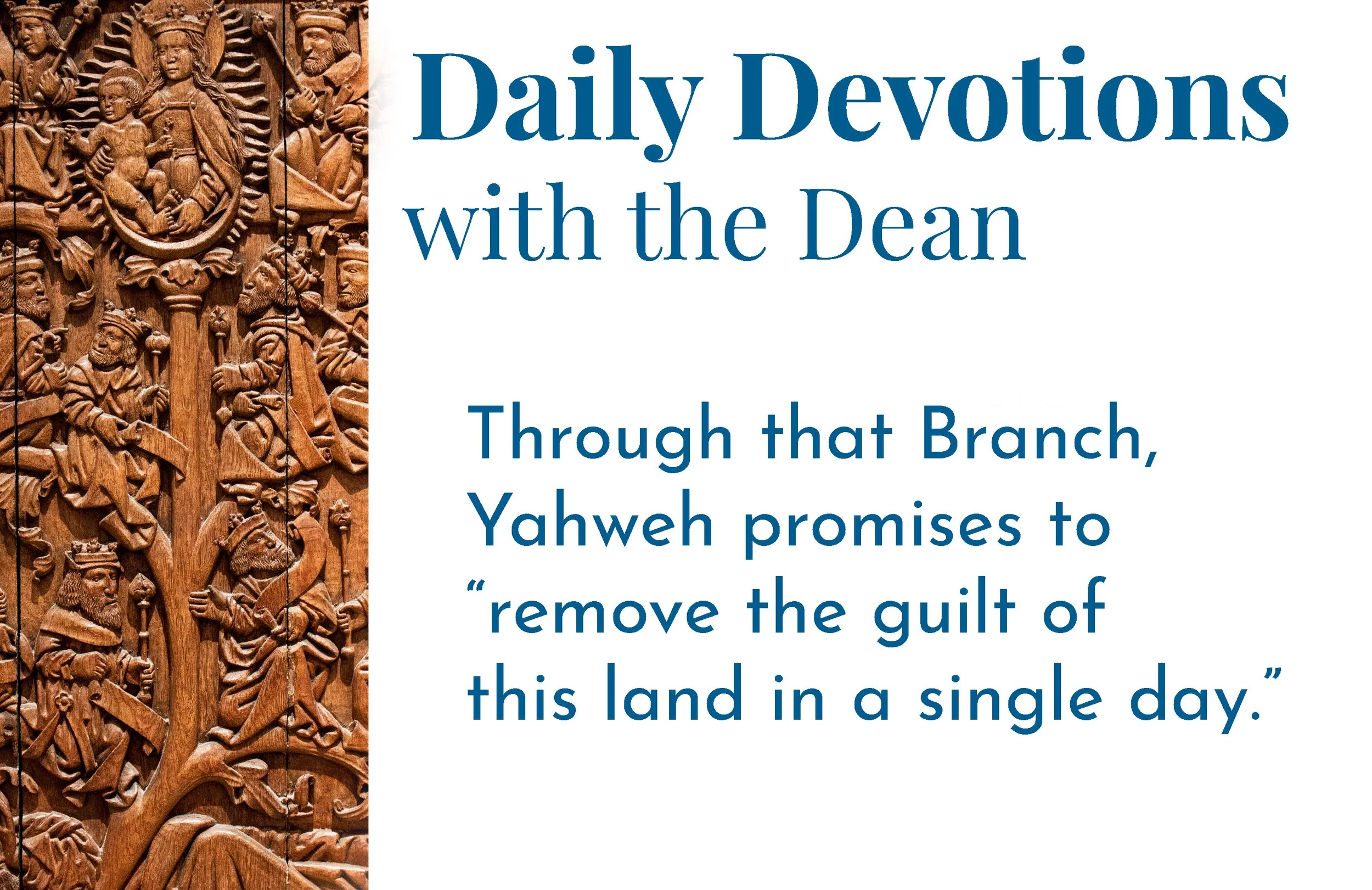Wednesday • 12/15/2021
Wednesday of the Third Week of Advent
This morning’s Scriptures are: Psalm 119:49–72; Zechariah 3:1–10; Revelation 4:1–8; Matthew 24:45–51
This morning’s Canticles are: following the OT reading, Canticle 11 (“The Third Song of Isaiah,” Isaiah 60:1-3,11a,14c,18-19, BCP, p. 87); following the Epistle reading, Canticle 16 (“The Song of Zechariah,” Luke 1:68-79, BCP, p. 92)
Zechariah receives a fourth nighttime vision of hope. “Then he showed me the high priest Joshua standing before the angel of the Lord, and Satan standing at his right hand to accuse him. And the Lord said to Satan, ‘The Lord rebuke you, O Satan!’” (Zechariah 3:1). Satan the accuser’s accusations mean nothing when the Lord steps in. Despite the complicity of the priesthood in Israel’s guilt, Yahweh intends to bring purity back into worship.
Symbolic of the guilt of past priests, Joshua the high priest appears at first with filthy garments. The LORD removes them and replaces them: “See, I have taken your guilt away from you, and I will clothe you with festal apparel” (Zechariah 3:5).
Yahweh knows that this can be but a partial measure, because every priest, including this Joshua, is a sinner, and can offer only tainted offerings. Thus, Yahweh promises a better Priest. He informs Joshua that he and his colleagues “are an omen of things to come; I am going to bring my servant the Branch” (Zechariah 3:8b). Through that branch, Yahweh promises to “remove the guilt of this land in a single day” (Zechariah 3:9b).
In Jesus Christ, that Branch has come. In his obedient life and in his sacrifice on the cross, Jesus Christ has removed the guilt of the whole earth “in a single day.” Praise be!
Revelation 4 (again)! A few weeks ago, the Daily Office Lectionary took us up to the Sunday of Christ the King (the culmination of the Christian Year) by telling us the destiny of two women, the Harlot of Babylon and the Bride of Christ (Revelation 12–22). History concludes with the separate destinies of these two. As part of the preface for that narrative, the Lectionary took us back to Revelation 4 and its throne room scene.
Here in Advent at the beginning of a new Christian Year, the Lectionary has taken us through Revelation’s letters to the seven churches (Revelation 2–3). These letters are portals into the various travails and victories of the church—the Bride in Waiting— through the ages. Appropriately, after inviting us to read those letters, the Lectionary revisits the throne room scene. We need to be reminded of the glory that stands above us in the midst of our struggles here below.
Things said a month ago are worth saying again:
Now, with Chapter 4, the Lord begins to pull back the curtain that, for now at least, separates earth and heaven. He shows John (and us) what’s going on behind the scenes: “…and there in heaven a door stood open!” (Revelation 4:11b). In his vision, John is taken, in the first place, to the throne room, where the Creator of heaven and earth still governs. Here, God the Father sits on a throne in a setting redolent with colors of the rainbow—his symbol that he is both creator and preserver of his good creation (Revelation 4:3).
Worship ascends to the Father from all of creation: from wild animal life (the lion), from domesticated creatures (the ox), from the birds of the air (the eagle), and from humanity (the human face—Revelation 4:6b). Twenty-four elders (Israel’s twelve tribes and Jesus’s twelve disciples) represent the full sweep of the biblical story, humanity’s true history and destiny. Each of the twenty-four has his own throne and crown. In humble adoration, each lays his crown at the feet of God.
Week after week, the struggling church here below accepts the liturgy’s invitation to join this heavenly chorus in their unending song, “Holy, holy, holy, the Lord God the Almighty, who was and is and is to come” (Revelation 4:8b). Their song is our song as well. For when we sing, with them, of the worth of our Lord and God, we re-center our lives around the fact that reality is thicker than what we can perceive with our senses.
Matthew: how shall we then live? I borrow this sub-heading from a book that Francis Schaeffer and C. Everett Koop co-wrote in the mid-1970s, surveying the challenge that believers face in advocating for life in a death culture. Jesus intends his sobering parable about an abusive household steward, I think, to make us draw back in horror, and say “May it never be!”
We have been so loved that Christ gave his life as a sacrifice for our sins (Matthew 26:28—the ultimate fulfillment of God’s promise to remove Joshua the high priest’s filthy clothes!). Christ has promised us his very presence each and every day (Matthew 18:20; 28:20). Christ has promised us a place in the coming renewal of all things: “Truly I tell you, at the renewal of all things, when the Son of Man is seated on the throne of his glory, you who have followed me will also sit on twelve thrones, judging the twelve tribes of Israel” (Matthew 19:28).
The very thought that we who are beneficiaries of such great gifts and have been entrusted with such a high calling should live abusive and self-indulgent lives — a horrific thought! How should we then live, indeed? Well, that’s largely what Matthew’s glorious gospel is all about, beginning with, “Blessed are the poor in spirit,” and running all the way through, “Teaching them all that I have commanded you” (Matthew 5:3; 28:20). That is who we are!
And that is why our keynote prayer in Advent is: Almighty God, give us grace to cast away the works of darkness, and put on the armor of light, now in the time of this mortal life in which your Son Jesus Christ came to visit us in great humility; that in the last day, when he shall come again in his glorious majesty to judge both the living and the dead, we may rise to the life immortal; through him who lives and reigns with you and the Holy Spirit, one God, now and for ever. Amen.
Be blessed this day,
Reggie Kidd+
Image: "O Radix Iesse" by Lawrence OP is licensed under CC BY-NC-ND 2.0


